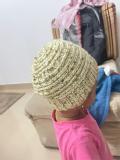
Kaggadasapura Road, Bangalore, India - 560093.
5
Details verified of Jayasree I.✕
 Identity
Identity
 Education
Education
Know how UrbanPro verifies Tutor details
Identity is verified based on matching the details uploaded by the Tutor with government databases.




Malayalam Mother Tongue (Native)
Hindi Proficient
English Proficient
Tamil Basic
![]() BITS, Pilani 2015
BITS, Pilani 2015
Master of Computer Applications (M.C.A.)
Kaggadasapura Road, Bangalore, India - 560093
![]() ID Verified
ID Verified
![]() Phone Verified
Phone Verified
![]() Email Verified
Email Verified
Report this Profile
Is this listing inaccurate or duplicate? Any other problem?
Please tell us about the problem and we will fix it.
Class Location
![]() Online Classes (Video Call via UrbanPro LIVE)
Online Classes (Video Call via UrbanPro LIVE)
![]() Student's Home
Student's Home
![]() Tutor's Home
Tutor's Home
Years of Experience in Crochet classes
5
3 out of 5 1 review
Shruthi
Crochet
It was ok
![]() Class Content
Class Content
![]() Teaching Method
Teaching Method
![]() Teacher's Knowledge
Teacher's Knowledge
1. Which classes do you teach?
I teach Crochet Class.
2. Do you provide a demo class?
Yes, I provide a free demo class.
3. How many years of experience do you have?
I have been teaching for 5 years.
Answered on 25/01/2024 Learn Art and Creativity/Crochet
The time it takes to crochet a blanket varies widely and depends on several factors, including the size of the blanket, your crochet speed, the complexity of the pattern, and your experience level.
For a simple and small baby blanket, a beginner might take several days to a week, while an experienced crocheter could finish it in a day or two. Larger blankets, such as those for adults or bedspreads, may take weeks or even months to complete, especially if using intricate patterns or smaller hooks.
Ultimately, the speed of crochet projects varies among individuals, so it's best to consider your own pace and the specific details of the project you're undertaking.
Answered on 25/01/2024 Learn Art and Creativity/Crochet
1. Make a Slip Knot:
2. Chain 4:
3. Join to Form a Ring:
4. Round 1:
5. Round 2:
6. Continue Adding Rounds:
7. Fasten Off:
Answered on 25/01/2024 Learn Art and Creativity/Crochet
The size of a crochet baby blanket can vary based on personal preference, the intended use, and the age of the baby. However, a common size for a standard crochet baby blanket is approximately 30 inches by 30 inches (76 cm by 76 cm) for newborns. For larger babies or as the child grows, you might choose to make a blanket that measures around 36 inches by 36 inches (91 cm by 91 cm) or even larger. It's advisable to refer to specific patterns or guidelines provided by the intended recipient or the project's purpose for more precise sizing.
Answered on 25/01/2024 Learn Art and Creativity/Crochet
The choice between knitting and crochet for creating garments is subjective and depends on personal preferences. Knitting often results in a more fluid and drapey fabric, making it ideal for items like sweaters, shawls, and delicate accessories. Crochet, with its thicker and denser fabric, is well-suited for sturdy and textured garments like cardigans, hats, and scarves. Each craft offers unique stitch patterns and textures, allowing for diverse design possibilities. Ultimately, the "better" choice depends on the desired look, feel, and functionality of the garment, as well as the individual's skill and comfort with each technique.
Answered on 25/01/2024 Learn Art and Creativity/Crochet
Certainly! Here are some helpful tips for beginners in crochet:
1. **Start with the Basics:**
- Begin with simple projects that use basic stitches like single crochet or double crochet.
2. **Choose the Right Yarn and Hook:**
- Pick a medium-weight yarn and an appropriate-sized hook for your first projects.
3. **Practice Consistent Tension:**
- Maintain even tension on the yarn to ensure consistent stitches.
4. **Learn to Read Patterns:**
- Familiarize yourself with crochet abbreviations and symbols to read patterns effectively.
5. **Use Light-Colored Yarn:**
- Light-colored yarn makes it easier to see your stitches and correct mistakes.
6. **Count Your Stitches:**
- Regularly count your stitches to avoid unintentional increases or decreases.
7. **Invest in Quality Tools:**
- Quality crochet hooks and yarn can make the learning process more enjoyable.
8. **Watch Video Tutorials:**
- Online video tutorials can provide visual guidance for different stitches and techniques.
9. **Practice Regularly:**
- Like any skill, practice is key. Regularly working on small projects helps build confidence and skill.
10. **Don't Fear Mistakes:**
- Mistakes are part of the learning process. Embrace them, and learn how to fix common errors.
11. **Join a Crochet Community:**
- Connect with other crocheters online or in person. Communities can offer support, advice, and inspiration.
12. **Take Breaks:**
- If you're feeling frustrated or tired, take a break and come back to your project later.
Remember that everyone progresses at their own pace, so be patient with yourself and enjoy the creative process of learning to crochet.
Class Location
![]() Online Classes (Video Call via UrbanPro LIVE)
Online Classes (Video Call via UrbanPro LIVE)
![]() Student's Home
Student's Home
![]() Tutor's Home
Tutor's Home
Years of Experience in Crochet classes
5
3 out of 5 1 review
Shruthi
Crochet
It was ok
![]() Class Content
Class Content
![]() Teaching Method
Teaching Method
![]() Teacher's Knowledge
Teacher's Knowledge
Answered on 25/01/2024 Learn Art and Creativity/Crochet
The time it takes to crochet a blanket varies widely and depends on several factors, including the size of the blanket, your crochet speed, the complexity of the pattern, and your experience level.
For a simple and small baby blanket, a beginner might take several days to a week, while an experienced crocheter could finish it in a day or two. Larger blankets, such as those for adults or bedspreads, may take weeks or even months to complete, especially if using intricate patterns or smaller hooks.
Ultimately, the speed of crochet projects varies among individuals, so it's best to consider your own pace and the specific details of the project you're undertaking.
Answered on 25/01/2024 Learn Art and Creativity/Crochet
1. Make a Slip Knot:
2. Chain 4:
3. Join to Form a Ring:
4. Round 1:
5. Round 2:
6. Continue Adding Rounds:
7. Fasten Off:
Answered on 25/01/2024 Learn Art and Creativity/Crochet
The size of a crochet baby blanket can vary based on personal preference, the intended use, and the age of the baby. However, a common size for a standard crochet baby blanket is approximately 30 inches by 30 inches (76 cm by 76 cm) for newborns. For larger babies or as the child grows, you might choose to make a blanket that measures around 36 inches by 36 inches (91 cm by 91 cm) or even larger. It's advisable to refer to specific patterns or guidelines provided by the intended recipient or the project's purpose for more precise sizing.
Answered on 25/01/2024 Learn Art and Creativity/Crochet
The choice between knitting and crochet for creating garments is subjective and depends on personal preferences. Knitting often results in a more fluid and drapey fabric, making it ideal for items like sweaters, shawls, and delicate accessories. Crochet, with its thicker and denser fabric, is well-suited for sturdy and textured garments like cardigans, hats, and scarves. Each craft offers unique stitch patterns and textures, allowing for diverse design possibilities. Ultimately, the "better" choice depends on the desired look, feel, and functionality of the garment, as well as the individual's skill and comfort with each technique.
Answered on 25/01/2024 Learn Art and Creativity/Crochet
Certainly! Here are some helpful tips for beginners in crochet:
1. **Start with the Basics:**
- Begin with simple projects that use basic stitches like single crochet or double crochet.
2. **Choose the Right Yarn and Hook:**
- Pick a medium-weight yarn and an appropriate-sized hook for your first projects.
3. **Practice Consistent Tension:**
- Maintain even tension on the yarn to ensure consistent stitches.
4. **Learn to Read Patterns:**
- Familiarize yourself with crochet abbreviations and symbols to read patterns effectively.
5. **Use Light-Colored Yarn:**
- Light-colored yarn makes it easier to see your stitches and correct mistakes.
6. **Count Your Stitches:**
- Regularly count your stitches to avoid unintentional increases or decreases.
7. **Invest in Quality Tools:**
- Quality crochet hooks and yarn can make the learning process more enjoyable.
8. **Watch Video Tutorials:**
- Online video tutorials can provide visual guidance for different stitches and techniques.
9. **Practice Regularly:**
- Like any skill, practice is key. Regularly working on small projects helps build confidence and skill.
10. **Don't Fear Mistakes:**
- Mistakes are part of the learning process. Embrace them, and learn how to fix common errors.
11. **Join a Crochet Community:**
- Connect with other crocheters online or in person. Communities can offer support, advice, and inspiration.
12. **Take Breaks:**
- If you're feeling frustrated or tired, take a break and come back to your project later.
Remember that everyone progresses at their own pace, so be patient with yourself and enjoy the creative process of learning to crochet.

Reply to 's review
Enter your reply*
Your reply has been successfully submitted.
Certified
The Certified badge indicates that the Tutor has received good amount of positive feedback from Students.